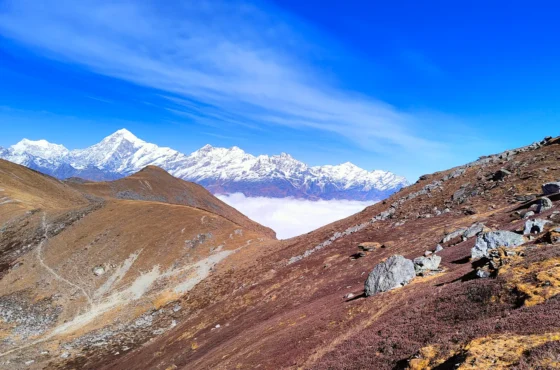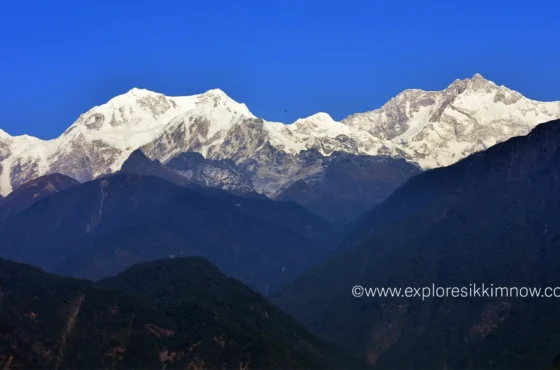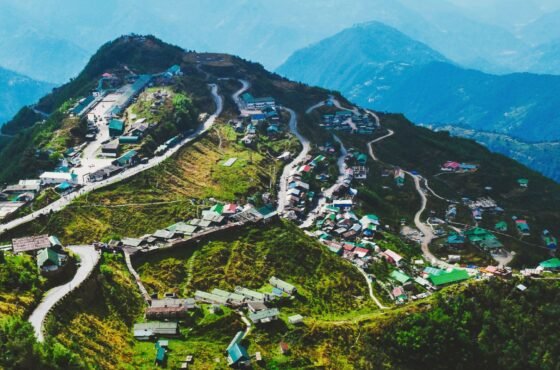North Sikkim stands apart as one of the most extraordinary Himalayan frontiers, a region where nature’s drama unfolds at every turn. Here, ancient Buddhist monasteries are perched on high ridges, alpine valleys burst into color with rhododendron blooms, and turquoise glacial lakes shimmer beneath snow-capped peaks.
Bordering Tibet and China, this district reveals a rugged, pristine world where multi-hued prayer flags flutter in icy winds and Indo-Tibetan cultures blend in remote mountain hamlets. A journey through North Sikkim is more than a sightseeing trip—it’s an immersion into a wild landscape shaped by rivers like the Teesta, dotted with geothermal hot springs, and crowned by the legendary Gurudongmar Lake at over 5,425m.
The surreal Chopta Valley, the vibrant Yumthang “Valley of Flowers,” and the windswept desolation of Zero Point await travelers seeking both awe and serenity. Each day brings fresh encounters—yak caravans, local delicacies, and heartwarming mountain hospitality. North Sikkim is not simply a destination; it is an adventure in altitude, solitude, and vibrant heritage.
Essential Information
- Trip Difficulty/Altitude: North Sikkim circuits rise quickly from moderate altitudes (2,400–5,425m). Anyone with known respiratory or heart issues should consult a doctor before booking. Acclimatization days, hydrating well, and gradual ascent are highly recommended.
- Best Months/Seasons: April–June for flowers and snow; late Sept–Nov for clear skies and landscapes. Avoid monsoon (July–Aug: landslides) and harsh winter (Jan–Feb: road closures, severe cold).
- Recommended Group Size: 4–10 people for cost efficiency, warmth, and permit ease.
- Price Estimation Notes: Rates vary by room/vehicle class and season. Foreigners cannot visit Gurudongmar Lake, only till Thangu/Chopta .
- Permits/Entry: Indian citizens require a permit (arranged by travel agent), needing ID and passport-size photos; foreigners need additional Sikkim permit and are restricted beyond Thangu/Chopta. All travel to North Sikkim is by registered tour agencies only, with strict permit checks at police outposts.
- Special Notes: Nights in Lachen/Lachung are cold year-round, with basic facilities (especially budget plans). Carry warm wear, sunscreen, any required medicines, and be prepared for flexible itineraries due to road/weather.
This North Sikkim itinerary prioritizes both the region’s top natural and cultural attractions and responsible pacing for a truly immersive and safe high Himalayan experience.
Tour Includes and Excludes
Cost Includes
- All accommodation (budget/standard as selected; twin-sharing rooms)
- All meals in North Sikkim (typically breakfast, lunch, dinner, tea/snacks as per lodge package)
- Private or shared vehicle transfers as per group choice
- Experienced local driver/guide
- All permits and entry fees for restricted zones
- Sightseeing as detailed in itinerary
- Oxygen cylinder (in vehicle) for emergency use in high-altitude regions
Cost Excludes
- Costs of reaching Gangtok (flight/train to NJP/Bagdogra, onward travel to Gangtok)
- Meals in Gangtok and during transit (except set inclusions)
- Tips, personal expenses, shopping, and extra snacks/beverages
- Camera/video fees (if charged at certain monasteries or sites)
- Medical/travel insurance
- Any additional sightseeing or changes to route not specified above
Overview
Nowhere else does the landscape shift so dramatically each day: traverse wild rivers, forests, and meadows, ascend to snow deserts above the tree line, and explore serene villages inhabited by the Lepcha, Bhutia, and Tibetan communities.
Every route is a journey through living geography and culture—you’ll witness monastic rituals in ancient gompas, savor warming Sikkimese cuisine, and learn about the challenges of life at high elevations close to the border frontier.
Tour Highlights
- Drive through one of India’s highest motorable highways, witnessing raw trans-Himalayan landscapes.
- Sunrise at Gurudongmar Lake—sacred, turquoise, and often frozen; dramatic Kanchenjunga views.
- The surreal, untrodden Chopta Valley; yaks, alpine flora, and accessible snow even in late spring.
- Yumthang Valley: an explosion of rhododendrons and wild Himalayan blooms (in season).
- Zero Point: The last frontier, where roads end at Indo-China boundary—an otherworldly white wilderness.
- Sikkimese village life: wooden homes, organic farms, interacted with Bhutia/Lepcha locals.
- Sulphur-rich hot springs, ancient Lachung monastery, and local Sikkimese cuisine (thukpa, momo, chhurpi).




